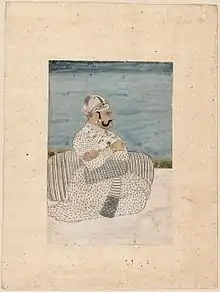Madho Singh I
Maharaja Sawai Madho Singh I (December 1728 – March 5 1768) was ruler of the state of Jaipur in the present-day Indian state of Rajasthan from 1750 to 1768.[1] He was the younger son of Maharaja Sawai Jai Singh II and after losing war of succession with his elder brother came on the throne after his suicide.
| Madho Singh I | |
|---|---|
| Maharaja Sawai of Jaipur | |
 Portrait of Savai Madho Singh of Jaipur | |
| Reign | c. 1750 – c. 1768 |
| Predecessor | Ishvari Singh |
| Successor | Prithvi Singh II |
| Born | December 1728 |
| Died | 5 March 1768 (aged 39) |
| Issue | Kunwar Prithvi Singh Kunwar Pratap Singh |
| Father | Jai Singh II |
| Religion | Hindu |
Biography
Madho Singh I was at Udaipur when his stepbrother Ishwari Singh committed suicide along with his three wives and a concubine by swallowing special cobra venom to evade the punitive campaign of Maratha chief Malharrao Holkar against him after murdering his minister Keshodas. Following this Madho Singh was crowned as the king of Jaipur state.[2]
Madho Singh invited Jayyapaji Shinde who arrived in due time along with Malharrao Holkar to dinner where the Maratha sardars were served poisoned food which they detected and evaded in time. Next day on 10 January 1751, about 5000 Marathas marched through Jaipur and started exploring the city's temples and monuments. Marathas seemed to have behaved towards Jaipur like city taken by storms. Suddenly the pent-up hatred of the Rajputs burst forth and a riot broke out at noon and citizens attacked unsuspected Marathas. The city gates were shut down and the Maratha party was ambushed from all sides, which ended with over 3000 Maratha men including 25 prominent commanders, a hundred brahmins, slave women and children massacred from midday till midnight with all their wealth and property looted. Madho Singh I posted assassins along the escape routes to kill off the Maratha envoys calling for aid.[3][4]
He won several important battles against other other kings Raja Jawahir Singh. He later reconciled with the Marathas after rewarding Holkar for his help in gaining the Jaipur throne by giving him the parganas of Rampura and Bhanpura in 1753. According to Vir Vinod which is 19th-century creation, Madho Singh gave poison to Raja Bakht Singh of Marwar but according to contemporary Persian sources Bakht Singh died due to cholera.[5]
Muhammad Shah's younger son Ahmad Shah was the Emperor of Delhi at that time. He was under great pressure because of the rebels outside and his own wazir inside. The wazir had become the de facto emperor. Ahmad Shah sought the help of Madho Singh, who had invited Abdali to invade and occupy India, and finally arrived at Delhi in October 1753 to meet the Emperor. Subsequently, he held long negotiations with wazir Safdarjung and forced him to return to his own province of Awadh. As recognition for his services Ahmad Shah granted Madho Singh the fort and district of Ranthambhore. In January 1763, he founded the town of Sawai Madhopur near Ranthambhore.
Death
He died in 1768 after a rule of 17 years and was succeeded by his son Prithvi Singh.
Cultural Contributions
His contribution to the field of art, architecture, town-planning, literature and religion was remarkable. He founded the well planned city of Sawai Madhopur, built several palaces including Madho Niwas in the Chandra Mahal complex of the City Palace, Madho Vilas the leisure palace in the centre of Jai Mahal, the Sisodia Rani ka Bagah (Queens gardens) as well as several beautiful temples. The painting atelier (surathkhana) was rejuvenated and a variety of court scenes and several portraits were painted there. He patronized Sportsmen of his State and even sent them to other places within the country to take part in competitions. Likewise, he sent artists from his State to other places to exhibit their skills and produce. He was fond of watching elephant fights, bullfights and other similar sports. He had Shaikh Sadi's Gulistan translated into Sanskrit. A few Sanskrit works were also attributed to him. Many dramas and poetic works were written under his patronage such as Veli Rukmani, Madhav Natakam, Madahava Vijaikavyama, Rajaritinirupana, Sataka, etc. Greatest contribution, at the end of his reign was political stability in the state of Jaipur.
See also
References
- D.K. Taknet, Razia Grover, Nandita Bhardwaj, 2016, Jaipur: Gem of India.
- G.S. Sardesai, New History of Marathas Vol. II, Pg.238
- G.S. Sardesai, New History of Marathas Vol. II, Pg.239
- Jadunath Sarkar, A History of Jaipur
- Rajasthan Through the Ages By R.K. Gupta, S.R. Bakshi p.156